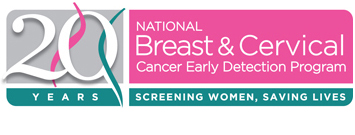20 Years of Screening Women and Saving Lives
 For more than 20 years, CDC's National Breast and Cervical Cancer Early Detection Program has provided free or low-cost mammograms and Pap tests to low-income women with little or no health insurance.
For more than 20 years, CDC's National Breast and Cervical Cancer Early Detection Program has provided free or low-cost mammograms and Pap tests to low-income women with little or no health insurance.
CDC's National Breast and Cervical Cancer Early Detection Program (NBCCEDP) has come a long way since the law was passed in 1990 authorizing the formation of the program. Originally limited to 8 states, the program now reaches all 50 states, 5 U.S. territories, the District of Columbia, and 12 American Indian/Alaska Native tribes and tribal organizations.
 Established under the Breast and Cervical Cancer Mortality Prevention Act of 1990, the program offers free and low-cost services to aid the fight against breast and cervical cancers. It places a special focus on addressing the disproportionately low screening rates among minority women and those who are low-income, uninsured, and underinsured. In 1993, NBCCEDP was expanded to include American Indian and Alaska Native tribes; in 1997, the program spread across the country to all 50 states.
Established under the Breast and Cervical Cancer Mortality Prevention Act of 1990, the program offers free and low-cost services to aid the fight against breast and cervical cancers. It places a special focus on addressing the disproportionately low screening rates among minority women and those who are low-income, uninsured, and underinsured. In 1993, NBCCEDP was expanded to include American Indian and Alaska Native tribes; in 1997, the program spread across the country to all 50 states.
Program Achievements
Since its inception, the NBCCEDP has served more than 3.9 million women, providing more than 9.8 million breast and cervical cancer screening examinations. Its success undoubtedly has saved lives. Funded programs have diagnosed more than 52,694 breast cancers, 2,856 invasive cervical cancers, and 136,837 premalignant cervical lesions. Beyond providing direct screening and diagnostic services, NBCCEDP promotes public and professional education and supports patient case management.
Over the years, the NBCCEDP has successfully implemented modifications to improve the program's structure and level of service for women in need. For example, new legislation in 2000 allowed states to offer women diagnosed with cancer through the NBCCEDP access to treatment through a special Medicaid option. All 50 states and the District of Columbia have since approved this option.
Qualifications for Program Services
To receive NBCCEDP screenings and other services, Federal guidelines require a woman to be underinsured or uninsured, and at or below 250 percent of the federal poverty level. They also must be between the ages of 40 and 64 for breast cancer screening, and 18 and 64 for cervical cancer screening services. An estimated 8 to 11 percent of women throughout the U.S. are eligible to receive services. To find out if you qualify for free or low-cost mammograms and Pap tests, contact your local program.
More Information
To find out if you qualify for free or low-cost mammograms and Pap tests, contact your local program.
- National Breast and Cervical Cancer Early Detection Program (NBCCEDP)
- Screening Program Data
- Local Program Highlights
- Breast Cancer
- Cervical Cancer
Scientific Articles
- Estimated effects of the National Breast and Cervical Cancer Early Detection Program on breast cancer mortality.
- Breast and cervical cancer screening practices among physicians in the National Breast and Cervical Cancer Early Detection Program.
- Meeting the cervical cancer screening needs of underserved women: The National Breast and Cervical Cancer Early Detection Program, 2004–2006.
- The impact of a national program to provide free mammograms to low-income, uninsured women on breast cancer mortality rates.
- Timeliness of breast cancer diagnosis and initiation of treatment in the National Breast and Cervical Cancer Early Detection Program, 1996–2005.
Get email updates
To receive email updates about this page, enter your email address:
Contact Us:
- Centers for Disease Control and Prevention
1600 Clifton Rd
Atlanta, GA 30333 - 800-CDC-INFO
(800-232-4636)
TTY: (888) 232-6348 - Contact CDC-INFO



